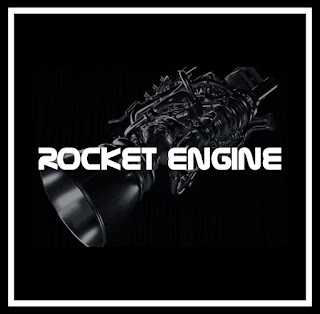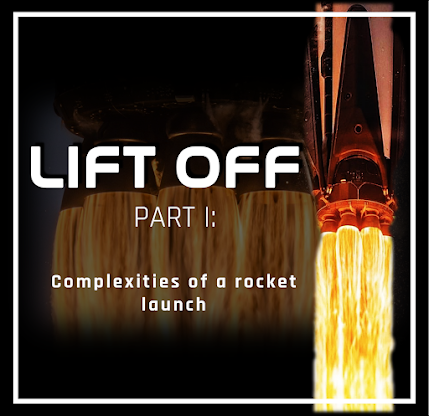THRUST TO WEIGHT RATIO
An Important aspect of a rocket
Thrust to weight ratio can be understood in simple terms as the ratio of the balancing forces. A rocket goes up or down or hovers at one place depending upon the forces acting on it. We will dive deep into the topic with FBD visualizations. (Force Body Diagram.) These diagrams are the simplest way to anticipate the forces and the movement of the rocket.
So, in this case, let's assume rockets mass be 10,000kg so the weight would be 1,00,000N or 100kilonewtons (100kN). Therefore, if a rocket produces a thrust of 100kN, then it will hover at a certain height (the height where its forces got equal). The rocket won't move an inch up or down, it will continuously hover at that position. Net velocity = 0 or in general terms, constant. The net acceleration becomes zero.
If you want to want up or down, you have to alter the thrust to weight ratio. Let's say, we reduced the thrust to weight ratio to 0.9:1. It means that, when the weight is 100kN, we apply 90kN of thrust. The rockets velocity will increase and the rocket starts moving in the downward direction. Now, here's the fun part.
The net acceleration and velocity are in a downward direction. If we alter the ratio back to 1:1, it won't stop. Rather it will continue going down BUT, the acceleration would become zero and the body will fall with a constant velocity. Therefore 1:1 ratio means the upward acceleration and downward acceleration are equal (since F=ma). This concept of constant velocity is called TERMINAL VELOCITY. Science students learn this term in fluid dynamics when a ball is dropped in a viscous fluid and after one point, the velocity becomes constant, until it reaches the bottom of the container.
RETURNING TO A HOVER:
So now, to bring the rocket back to its hover stage, you have to apply TWR more than 1:1. In our case since we decreased it by 0.1 units, now we have to increase the thrust by 0.1 units and therefore apply the ratio to 1.1:1. Therefore, the rocket downward velocity is opposed by an upward acceleration, i.e. for 100kN of weight, we apply 110kN of thrust. Soon, as the velocity approaches zero, we switch back to 1:1 TWR i.e. for 100kN or weight, 100kN of thrust is applied to return back to the hovering stage.
The same thing is possible in a reverse manner. Increasing the TWR to increase the velocity and then lowering it to get back to the hovering stage can also be done.
TWR DURING LAUNCH:
If you were driving an aeroplane, the thrust to weight ratio less than one would have worked, provided the lift to drag ratio is more than one. Rockets operate in a wide range of gravitational environments. They even have to propel themselves in the harsh vacuum and weightlessness of space.
Reusable rockets need a TWR quite high while an expendable (one-time use) rocket doesn't require much. Though in both cases, the ratio has to be more than 1:1.
While launching a rocket you need a thrust to weight ratio greater than equal to one. To get the rocket off the pad (launchpad) the engines ignite and produces an acceleration that is more than the weight of the rocket. That acceleration is expressed in multiples of gravitational acceleration as 1g, 2g, 3g etc.
The TWR of the rocket improves as the propellant burns. The maximum TWR is achieved when the engine consumes the maximum fuel i.e. when it works at its peak potential. Habitually, a rocket engine is not allowed to function at its peak ability since it will engender more heat and thus melting the nozzle. Usually, the ratio varies around 1:1 but is always higher than one. Maybe 1.3:1 or 1.5:1 is is considered a ratio to be worked with.
SOME EXTRA ANALOGIES:
There is also a direct relationship between TWR and payload capacity. If the TWR is more than 1:1, that means, the thrust produced is more than the overall weight of the rocket, then there is a chance to add more payload until the ratio turns to approx 1.5:1. Adding more payload on the top of the rocket reduces the cost per kilogram put into space, therefore, reducing the cost of the rocket. So that's a win-win situation.
The specific impulse also plays a major role in TWR. Specific Impulse is similar to the fuel efficiency of the car. It is the measure of how efficiently the engine consumes fuel over time. Therefore, the more the specific impulse, the more is the duration for which thrust is produced and thus there's a win again. Rocket can produce more thrust over time.
-------------------------------------------------
JUST FOR FUN, COMMENT DOWN THE THRUST TO WEIGHT RATIO OF THE STARSHIP ROCKET. IF YOU DO SO, YOU WILL BE FEATURED ON MY NEXT BLOG...-------------------------------------------------
That's all for today guys, my Rocket Engine Part 3 will be arriving next week. Till then, stay tuned, follow for regular updates, comment for fruitful discussions.







nice
ReplyDelete